Recently, I was driving through farm country up and over the mountain behind my house in Switzerland when I passed a sign advertising farm fresh fruits and vegetables. After driving through orchards, I reached a beautiful farm at the end of the road. I was expecting a typical outdoor farm stand, like the many found throughout the country, so was surprised to find an entire room dedicated to produce, preserves, nuts, eggs, sausage and milk. Fresh (un-pasteurized) milk! I was always hoping to find a local source and here it was.
The young farmer came out to take my milk order. While I waited, Brown Swiss calves came up to watch me through the window. When he returned with my liter of milk in a plastic bottle I vowed to look for a traditional metal milk container to carry home future purchases. Upon returning home, I decided it was once again time to make my own yogurt. Never before have I made it with fresh, un-pasteurized milk.
Most yogurts in Switzerland are wonderful, readily available and reasonably priced. Truth be told, I do usually buy them. But, I love my plain and honey-infused versions so don’t mind spending the time making them. Years ago in the States, it was tough to find plain yogurt. I disliked all the sugar added to flavored varieties and sometimes things labeled as yogurt were actually set with gelatin rather than naturally fermented. And I was a poor student so, for the sake of economy, I learned to make my own.
There are loads of recipes and methods out there using everything from incubating yogurt machines, electric heating pads, double boilers, jars floating in thermoses filled with hot water, and powdered yogurt culture. The method I use is as basic and equipment-free as possible. All you really need is a saucepan, a whisk, some clean old jars or a bowl, milk and a few spoonfuls of plain yogurt. A thermometer is helpful but not necessary. I didn’t use one for years.
My method is extremely simple and can be used with any mammal milk. The possibilities are endless and, in some cases, disturbing. Heat 1 liter (1 quart) of whole or reduced fat milk (not long life) to just under boiling – about 80 °C (176 °F) to kill any undesirable bacteria and to denature the milk proteins so the yogurt will thicken.
Next, cool the milk to baby bottle temperature about 43 °C (110 °F). Whisk in the bacteria culture (4 tablespoons plain yogurt). The milk to starter yogurt ratio is 1 cup milk : 1 tablespoon plain yogurt so you can make any amount.
If desired, honey can be whisked in at this stage – about 1 tablespoon per cup of milk.
Transfer the warm milk and yogurt mixture to clean jars. (If adding preserves, place in the bottom of the jar before slowly and carefully adding the milk.) Seal tightly. If jars are not available, pour into a large or several small bowls and seal with plastic wrap.
At this point, the mixture has to sit undisturbed and the temperature has to be maintained for 5 to 12 hours to allow fermentation. Jars can be placed in a large, plastic picnic cooler. I find it easier to heat my oven to about 35° C (85° F) while the milk is in the cooling stage. Turn the oven off and leave the door closed. Place the jars on a sheet pan in the oven, cover them with a dishtowel, close the door and leave them alone for about 5 hours. Carefully check to see if it has thickened. If not, leave them longer to continue fermenting and thickening.
When thickened, carefully transfer to the fridge and let it chill for at least 4 hours before eating it. The yogurt will keep for about 4 to 5 days.
If thick, Greek-style yogurt is preferred, simply drain the finished product in cheesecloth.
I love eating it topped with fruit, home made granola, preserves, or honey and nuts.
- 1 liter / 1 quart whole or reduced fat milk (not long life)
- 4 tablespoons plain, unflavored yogurt with active live cultures
- 4 tablespoons honey (optional)
- 8 tablespoons fruit preserves (optional)
- Place the milk in a saucepan and heat to: 82º Celsius / 180º Fahrenheit (just below the boiling point). Take care to not scald the bottom.
- Remove from heat and let cool to lukewarm, around: 40.5º to 43º Celsius or 105º to 110º Fahrenheit (baby bottle temperature).
- While the milk is cooling, slightly heat oven for several minutes so it is warm, around 35º Celsius / 85º Fahrenheit. Turn off and leave the oven door closed.
- A skin will form on top of the cooling milk. Remove it. Whisk in 4 tablespoons of yogurt. (At this stage, honey may be whisked in, if desired.)
- Transfer to clean jars with tight-fitting lids or pour into glass or ceramic large or small bowls and cover with plastic wrap. If using preserves, place in the bottom of the jars or bowls before carefully and slowly add the milk.
- Place on a sheet pan. cover with a dish towel. and place in the warm oven. Close the oven door. (Alternatively, place in a warm place or inside a large, plastic cooler.)
- Let sit completely undisturbed for 6 to 12 hours. When the yogurt has thickened, carefully drain excess liquid, if necessary.
- Place in sealed containers in the refrigerator for at least 4 hours before eating. Use within 4 to 5 days. Serve plain, with granola, topped with fruit, preserves or honey. Don't forget to save a small amount to make the next batch.
- If it does not set, either the milk was too hot when the yogurt was stirred in or the cultures were not live in the yogurt. Sometimes lower fat milk will yield slightly grainy yogurt.
- Yield: 1 liter / 1 quart plain yogurt
- TO MAKE THICK GREEK-STYLE YOGURT Line a colander with cheesecloth and place over a bowl taking care the bottom of the colander is well above the base of the bowl. Pour finished yogurt into the colander. Gather four corners of the cheesecloth and squeeze excess liquid out of the yogurt. Tie off the top of the cheesecloth just above the yogurt mass with string. Place back in the colander over the bowl and let rest in refrigerator 2 to 3 hours. Squeeze any excess. Store up to 5 days in a closed container in the refrigerator.

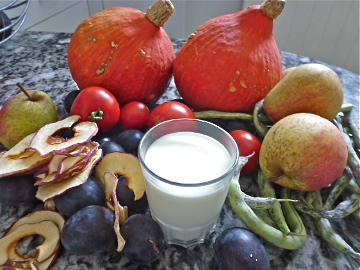
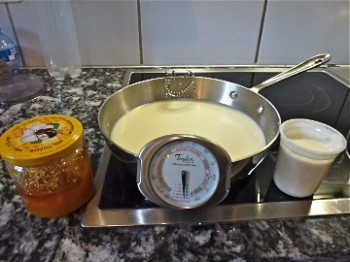

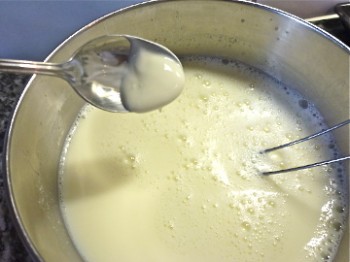
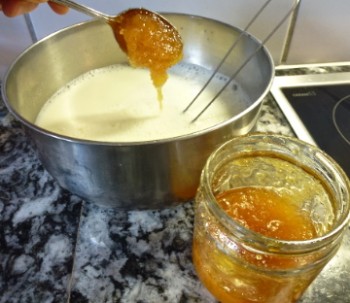

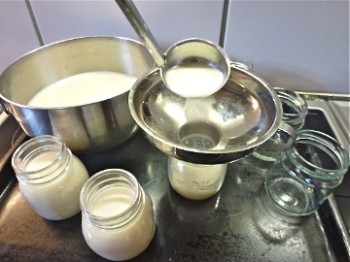
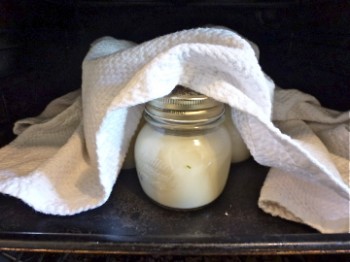
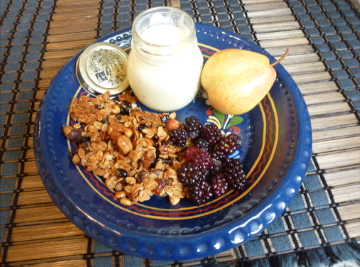





[…] Serve with milk or over purchased or homemade yogurt. […]